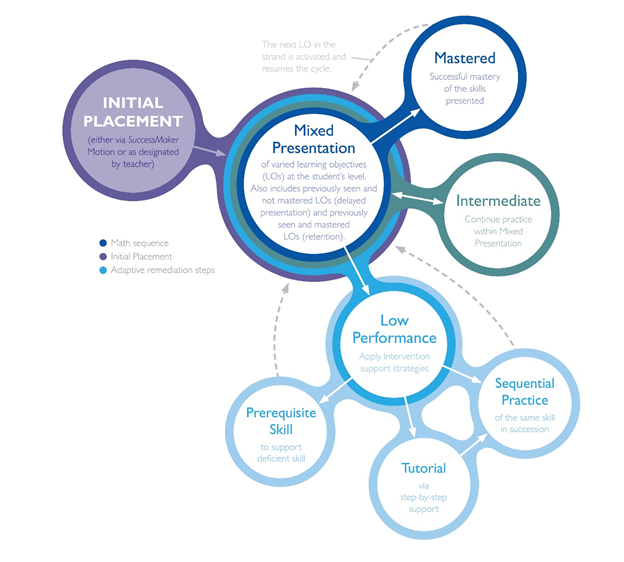Math Adaptive Motion Learning Model
The Adaptive Motion in SuccessMaker Math directs each student’s path through the content. Skill objectives within and across strands are organized into a Mixed Presentation sequence of skill objectives.
-
Initial Placement (IP) motion finds the student’s appropriate level in the course. This level is suitable for learning, neither too easy nor too difficult.
-
The proportion of instruction across concept areas is adjusted for the individual so that weaker areas receive more emphasis, thereby reducing the gap between the student’s areas of relative weakness and strength.
-
Mastery decisions are based on the probability of the student answering the next exercise correctly, not merely on the student’s current percentage of correct answers. The courseware, thereby, responds more quickly to student understanding, resulting in a more efficient use of the student’s time.
-
Personalized intervention guides individual student learning. When the student encounters difficulties, the system employs various instructional strategies, including sequential practice within the areas of difficulty, presentation of brief tutorials, and/or review of prerequisite material.
-
Dynamic sequencing of content adjusts to the individual student. When the student experiences repeated difficulties with new material, the material is set aside (delayed) for subsequent presentation. The goal is to challenge the student without frustrating him, and thereby to keep him engaged in the courseware.
-
By periodically checking the student’s recollection of previously mastered material, the system assures the student’s firm basis for further learning.
-
The time a student requires to achieve specified gains is estimated and reported to the teacher. The estimate is initially based on the data from past users of the courseware. Then, as the system analyzes the individual student’s rate of progress, it adjusts that estimate. The courseware thus constitutes a learning system that adapts to the individual student. The curriculum structures, Adaptive Motion algorithms, and reporting functions that make this possible are designed to engage the student and assist the teacher. These product features are the consequence of continuous model refinement based on a sustained program of research.
